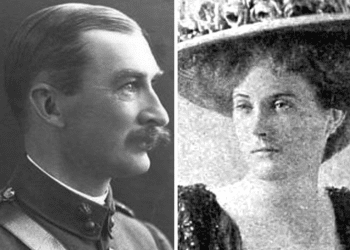A column about days gone by in Melksham by local historian Lisa Ellis
Melksham Parish Church Service Charges in 1800
PARISH records list baptisms/christenings, marriages and deaths.
These books are invaluable to genealogists for names and dates of their predecessors. But, if you open the book to its first few pages, you might find a glimpse into life hundreds of years ago.
For instance, you may read of the early roots of the parish and how it was formed, or notations of people who were excommunicated. In the Melksham burials and baptisms book for St Michael’s Church, dating from 1798, the vicar had listed all the church fees charged for various services.
The following was written by Joseph Smith, vicar of Melksham from 1802 to 1825 to note the fees that had been set by the previous vicar, Robert Price.
1800 – Fees taken by the present vicar (but not binding upon his successors)
Note: rates are columned in order of pounds (£), shillings (s) and pence (d)
BAPTISM £ s d
Fee for baptism on days not prayer days 0 2 6
Fee for churching on days not prayer days 0 2 6
MARRIAGE
Fee for publication of banns of marriage 0 2 6
Fee for certificate of publication of banns 0 2 6
Fee for marriage by banns 0 5 0
Fee for marriage by license 1 0 0
Fee for certificate of marriage 0 2 6
NB – For legal purpose, a certificate of marriage must be on a 5 shillings stamp
Fee for each search of the register 0 1 0
if accompanied with a written copy or extract 0 2 6
BURIAL
Extracts from Burn’s Ecclesiastical Law
No person may be buried in the church or in any part of it, without the consent of the incumbent. Our Common Law hath given this privilege to the Parson only, exclusive of the Bishop. Neither the ordinary himself, nor the church Wardens, can grant license for burying to any within the Church, but the Parson only in his general capacity of Incumbent and as the person whom the Ecclesiastical Laws appointed the Judge of the fitness or unfitness of this or that person to have the favour of being buried in the church.
The Incumbent may prescribe his own reasonable terms for such permission, as also for monuments and the vaults and graves lined with brick or stone, and for gravestones, and all matters for which the incumbent’s permission is necessary.
The Common Law hath one exception to the recepity of the leave of the Parson for burying in the Church, namely, where a burying place within the Church is presented for as belonging to a Manor House.
£ s d
For a head and foot stone in the church yard if with intermediate stone or without 0 10 6
For a flat stone covering the whole grave 1 1 0
For a raised tomb 2 2 0
If with rails round the same 4 4 0
For a single grave lined with brick or stone to those who can well afford it 1 6 0
Double vault 2 2 0
For burial from another parish in a common grave 0 10 6
If a single vault lined with brick or stone 2 2 0
For a monument within the church or chancel 2 2 0
For every additional memorial upon a tomb or stone already erected 0 5 0
For burial within any part of the church, according to the baptism of the party, the present vicar has in three instances had £5 5s 0d for each.
In a Lord of the Manor’s vault or private chancel, he has only received £1 1s 0s as a compliment; but more if the corpse be from another Parish.
The internment within the church, or any part thereof, of any individual gives no right to the family in future. The permission is for the individual only, and therefore to be paid again for an additional corpse.
Pictured: The Parish records’ book
























